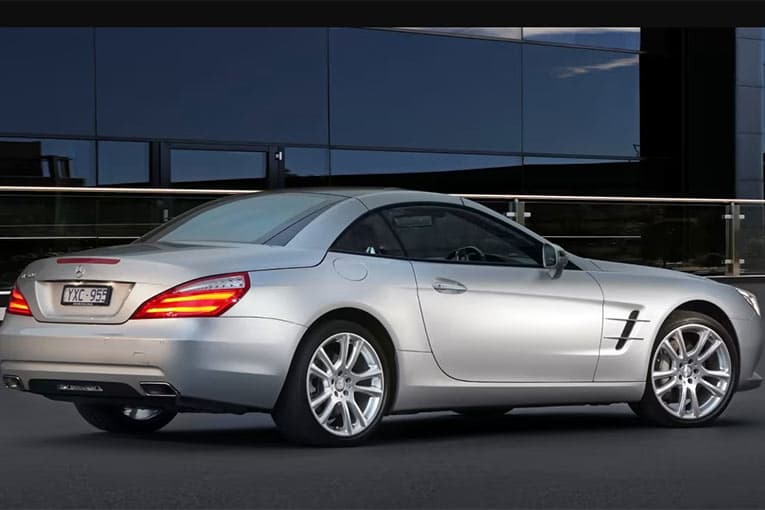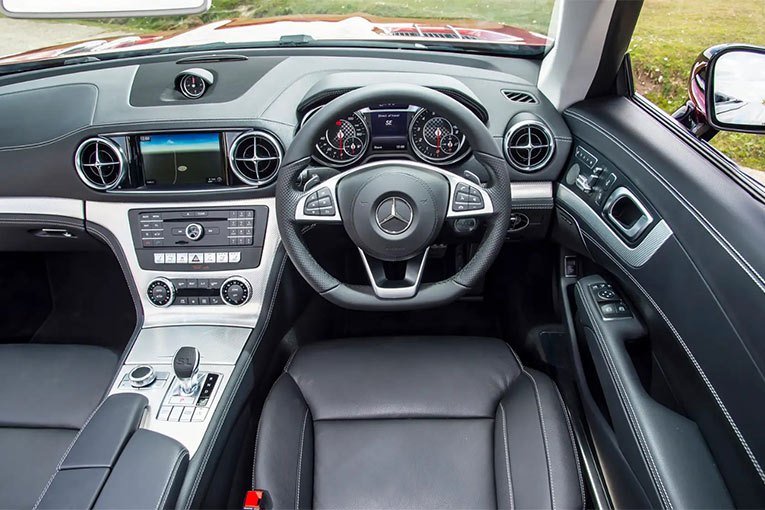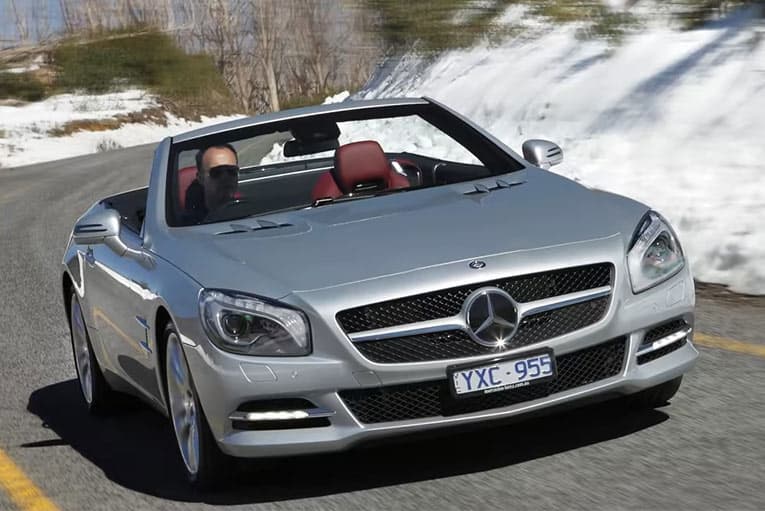The Mercedes-Benz SL is now in its sixth generation. This latest SL roadster has a new design, but much has stayed the same. The new SL has kept its traditional proportions with a set back passenger compartment, long bonnet and muscular rear end. The radiator grille and the headlights have have a bit of similar design as in the smaller SLK, while the rear lights look very similar to those in the previous model. Compared to the predecessor, the new SL is 50mm longer and 57mm wider. However, due to the consistent weight reduction, the new SL is considerably lighter. The new SL is the first Mercedes-Benz series-production model with an all-aluminium bodyshell. It weighs around 110 kilograms less than it would be using a steel bodyshell. The frame of the roof is made of magnesium, making the roofs around six kilograms lighter. The total weight of the SL 350 is 1685 kg. That makes it 140 kilograms lighter than the preceding model.
The roof of the SL opens or closes in 20 seconds with a push of a button. In addition to the painted roof, you can have a glass roof or a new transparent roof that you can switch to light or dark. With the roof up, the new SL provides a sporty driving experience, but a roadster is at its best with the roof down. The car looks much better with the side windows lowered, but at a higher speeds, it is more comfortable to travel with the side windows up as it reduces the winds inside the cabin. With the draught-stop, the SL provides almost draught-free driving experience speeds up to 80 km/h. A conventional, manually operated folding-frame draught-stop comes as standard. A new, electrically operated draught-stop is available as an optional extra. As it was in the previous model, the Airscarf system is also available as an option. Airscarf emits preheated air from an orifice in the head restraint making it more comfortable to drive with the roof open when the temperature gets a bit cooler.

For a big roadster like the SL, a V8 would sound like a right engine choice, but this V6 isn’t too bad either. The new six-cylinder, naturally aspirated engine in the SL 350 has the same displacement as its predecessor, 3499 cubic centimetres. The biggest difference between the new V6 unit and its predecessor is a reduction in the V-angle between the cylinder banks from 90 degrees to 60 degrees. The 3.5-litre V6 produces 306 hp. That is 11 hp less than its predecessor. Instead it delivers 10 Newton metres more, with a top torque of 370 Nm. The 306 horsepower might not sound very impressive in these days, but still the SL 350 can accelerate from zero to hundred km/h in 5,9 seconds and reach a top speed of 250 km/h. This kind of performance is enough for most of the drivers, but it still would be nice to have just a little bit more power, and those nice sounds provided by the V8.
Great thing about this V6 is its hugely improved fuel efficency. The combined fuel consumption is just 6,8 l/100km. That is almost 30 percent less than its predecessor. The Eco start/stop function is standard with all the engines. All SL models are equipped with the 7G-Tronic Plus automatic transmission. The transmission offers Eco and Sport automatic driving programs and the manual mode, if you want to change gears yourself. In the manual mode the gear changes are operated via shift paddles on the steering wheel, as the small gear lever in the centre console is used only to choose between N, R and D.

I really loved the previous Mercedes-Benz SL, so I kind of hoped that they wouldn’t change much for this new model. On the other hand, as it is a completely new generation, you would hope that it would look more different than before. Not that it wouldn’t look great, but we kind of saw this front end allready in the latest SLK. And that centre console, isn’t that the same one that is used in almost every Mercedes model? But putting these design details aside, the new Mercedes-Benz SL is a great drive, and with a roof down, a great fun on a summer day.
Specification
Engine
- Petrol
- 6-cylinder
- 3498cc
Power
- 225 kW (306 hp) / 6500rpm
Torque
- 370 Nm / 3500-5250rpm

Transmission
- 7-speed automatic
- RWD
0-100km/h / 0-62mph
- 5.9 seconds
Top speed
- 250 km/h
Fuel consumption
- 6.8 l/100km
CO2 emissions
- 159 g/km










